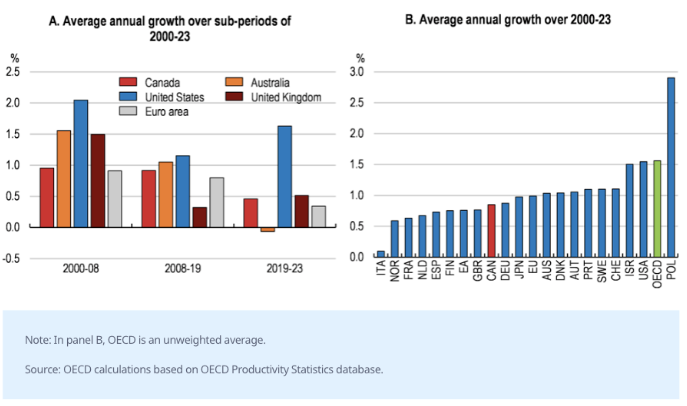Stop Losing Ground!
- Paul Allard

- il y a 6 jours
- 6 min de lecture
A Practical Roadmap for Sustainable Transformation Built on Sustainable AI, Data Governance, and Durable Supply Chains
Introduction
Companies in Canada and France (and in Europe) are facing a productivity crisis that threatens competitiveness. Three overlapping forces — digital catch-up (AI, data, automation), environmental pressures (regulation, risk, social acceptability), and geo‑economic shifts (trade controls, supply‑chain disruption) — are accelerating losses in output, market share and cost-efficiency. To reverse this trend you need a coherent, measurable Sustainable Transformation strategy that brings together sustainable AI, rigorous data governance, and supply‑chain resilience.
This article gives a scannable, actionable plan companies and public sector leaders can use now. It explains where to start, what to prioritize, how to measure progress, and how to choose the right partners (from sustainable transformation consulting to AI governance consultants and ESG consulting firms).
Why act now: the productivity context
Canada: productivity growth has been essentially flat for a decade (1), with post‑pandemic slowdowns across goods-producing sectors (2) and GDP per capita lagging other G7 (3) countries (4).

France: productivity has declined over the last decade and dropped further since the 2020 health crisis (5), in part due to lower investment in innovation and lagging private investment in AI (6) compared with the U.S. and China (7).

Both countries’ trends reflect underinvestment into the production apparatus, digital tools (AI, data, etc.), into innovation and R&D, leading to weak diffusion of innovation across firms, and structural misalignments in the economy. Left unaddressed, this leads to higher relative labor costs and eroded competitiveness.
This productivity crisis has three root causes. First, AI is under‑used and widely misunderstood — teams often lack practical know-how, clear scope and robust AI governance, so projects can’t scale or deliver reliable outcomes beyond Proof of Concept initiatives. Second, weak Data governance - where the classic GIGO effect (“garbage in, garbage out”) leads to poor decisions and compliance risks. Third, Supply‑chain disruptions — where suppliers fail to meet customers’ expectations for data utilisation or ESG performance — break service levels and damage brand trust.
For busy decision‑makers, this is overwhelming: where do you begin? The good news: proven frameworks exist that convert pilots into prioritized, measurable initiatives and embed them into operations. Applied across Sustainable AI, Data governance, and Supply chain resilience, these frameworks turn short‑term wins into medium‑ and long‑term sustainable productivity gains.
A simple, integrated way to respond: the 6-step Sustainable Transformation Framework
Use this framework to align digital transformation consulting, sustainable AI consulting, data governance consulting and supply chain resilience efforts into a single, measurable program.
Assess: baseline the problem (0–3 months)
Run a productivity loss audit: map processes with the highest strategic importance, and that show fiction such as time/cost drag (manufacturing throughput, order-to-cash, procurement cycle times).
High level capability Inventory: identify people (roles and skills, e.g. AI, data, ESG), processes (e.g. supply chain), data (e.g. market data, personal data), and technologies (e.g. ERPs, data platforms) support these key processes.
Risk scan: catalogue environmental and geo‑economic risks (regulatory exposures, key supplier fragility, tariffs).
Vulnerability assessment: Identify gaps and vulnerabilities leading to productivity loss.
Deliverable: a one‑page dashboard showing top 5 process drains, 3 critical gaps in skills, data and technologies, and 3 supply vulnerabilities.
Why this matters: accurate scoping keeps early investments focused. Many projects fail because they don’t start with a reliable current state assessment, project scoping and risk assessment.
Prioritize: pick high-impact, low-friction pilots (0–6 months)
Choose projects with measurable ROI within 6–18 months. Examples:
Sustainable AI pilot: automate high‑volume decision work (predictive maintenance, demand forecasting) with carbon-aware model selection and lifecycle measurement.
Data governance quick wins: implement a data catalog, business glossaries, and a few data quality rules to unblock analytics.
Supply‑chain resilience pilot: dual-sourcing for a critical component, or an inventory optimization project that reduces stockouts and carrying costs
In all cases, you need to establish solid governance around your project to ensure stakeholder alignment and scalability. A cross-functional steering committee — bringing together IT, operations, procurement, legal, sustainability, and business owners, and supported when needed by external expertise from a transformation or ESG consulting firm — should guide progress measurement and key decision-making. In addition, change management forums create a structured space for teams to align, share updates, and address challenges throughout the transformation.
Deliverable: 3 prioritized pilots project charters, with owners, budgets, and KPIs and supporting steering committee and change management forums.
Design: build reusable blueprints (1–3 months per pilot)
For each pilot, define architecture, data flows, compliance checks and sustainability metrics.
Sustainable AI design: include model interpretability, energy/cost profiling, bias testing, and deployment rollback criteria — this is where sustainable AI consulting and AI governance consulting add value.
Data governance design: policies for lineage, ownership, access controls, and a plan to operationalize a reliable data strategy.
Durable supply‑chain design: supplier segmentation, contingency routing, and metrics for lead-time variance.
Deliverable: implementation blueprints and an operating model for scale.
Pilot & Measure: iterate fast (3–9 months)
Deploy end-to-end in a controlled environment and track agreed KPIs:
Sustainable AI KPIs: accuracy deltas, energy consumption per inference, reduction in manual hours, regulatory compliance checks passed.
Data KPIs: data quality scores, mean time to insight, proportion of decisions supported by trusted data sources.
Supply‑chain KPIs: fill rate, lead-time variability, single-supplier dependency ratio.
Use A/B testing or parallel runs where possible. Capture lessons and cost of implementation.
Scale: industrialize what works (6–24 months)
Convert pilot code, processes and governance into enterprise standards:
Roll out AI models via MLOps with integrated sustainable AI practices and monitoring by AI governance consultants.
Embed data governance into change control, procurement and vendor contracts to sustain a reliable data strategy.
Implement supply‑chain resilience playbooks across product lines to build a durable and sustainable supply chain posture.
Govern & Sustain: continuous improvement (ongoing)
Establish recurring KPIs, periodic audits, and budget cycles that fund ongoing optimization.
Adapt project governance and cross-functional steering committee and change management forums to continuous operations
Here are examples of KPIs to track sustainable transformation progress, at board and operational levels
Productivity: output per labor-hour for priority processes (monthly).
Financial: cost savings and revenue uplift attributable to pilots (quarterly).
Data: % decisions supported by trusted datasets; data quality score (monthly).
AI: model performance, inference energy per prediction, number of incidents requiring rollback (monthly).
Supply chain: fill rate, average lead time, supplier concentration ratio (monthly).
Sustainability: build your TOC (Theory of Change) scoping out how your activities lead to projected outcomes tied to operations or logistics and follow the metrics (quarterly).
Quick wins to get momentum (first 90 days)
Kick off an executive steering committee and 90‑day action plan.
Run a four-week diagnosis sprint: map 3 processes, 3 data assets, 3 suppliers.
Select a key strategic process for your sustainable AI proof-of-concept so you can demonstrate return on investment early.
Deploy a basic data catalog and assign two data stewards.
Identify one critical supplier for redundant sourcing or inventory buffer.
How to select the right consulting partners (checklist)
Look for cross-discipline experience: the partner must blend sustainable AI consulting, data governance consulting and supply‑chain resilience consulting — not siloed specialties.
Evidence of outcomes: ask for case studies with clear, measured productivity gains and reproducible playbooks.
Regulatory and governance expertise: ensure they provide AI governance consulting in a controlled environment, meaning they master data risks and disciplines such as data privacy and data governance.
ESG integration: prefer an ESG consulting firm or sustainability consulting team that can tie operational changes to disclosure frameworks.
Delivery model: prefer transformation consulting firm models that combine advisory with on‑the‑ground implementation and knowledge transfer.
Organizational and funding considerations
Treat Sustainable Transformation as a program, not a project. Allocate multi-year funding and measure against business outcomes.
Balance central coordination and local ownership: central standards (data, AI governance, procurement) with business-unit led pilots.
Expect cultural friction; invest 10–15% of the program budget in change management and upskilling.
Final note: integration is the strategic advantage
Digital modernization, sustainable AI, reliable data strategy, and supply‑chain resilience are most powerful when combined. A siloed approach wastes time and money. Companies that converge these streams under a coherent Sustainable Transformation program — with support from transformation consulting firms, sustainable transformation consulting teams, AI governance consultants, data governance consulting partners and ESG consulting firms — will stop the productivity erosion and regain competitiveness.
Paul Allard, MBA
ESG and Sustainable transformation expert
Managing Partner at Persevere Consulting Inc.
Persevere Consulting Inc. © 2025
Enabling Sustainable Transformation ™
About Persevere Consulting - Enabling Sustainable Transformation TM
We are entrepreneurs of sustainable innovation. Through fast diagnosis and focused, quantifiable actions built around Sustainable AI, rigorous Data governance, enhanced Supply‑chain processes, and pragmatic Sustainability measures, we translate strategy into operations that cut costs, boost resilience, and give our clients a competitive edge.
Founded by seasoned experts and entrepreneurs, Persevere Consulting is an AI-native boutique firm deeply invested in the future of our world and partners with clients who share this vision.
Disclaimer: AI contributed to the creation of this article, but it was guided, reviewed and fact-checked by Persevere Consulting’s human experts. Please note that the content and material provided in this article is for general information purposes only. It is not to be taken or relied upon as legal or management advice and should not be used for professional or commercial purposes. This article is intended to communicate general information about relevant sustainable productivity, sustainable AI, and data governance matters as of the indicated date. The content is subject to change based on a constantly evolving environment.
[3] https://rsmcanada.com/insights/economics/how-canada-can-turn-around-its-lagging-productivity.html#:~:text=On%20the%20global%20stage%2C%20Canada,up%20and%20boost%20its%20productivity.
[6] 2024 report on IA du Human-Centered Artificial Intelligence from Stanford university. See Stanford University (2024), AI Index Report 2024, Human-Centered Artificial Intelligence, April.
[7] Draghi M. (2024), The Future of European Competitiveness, Part A, op. cit.


Commentaires